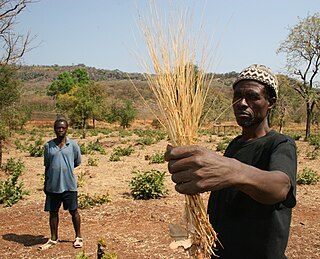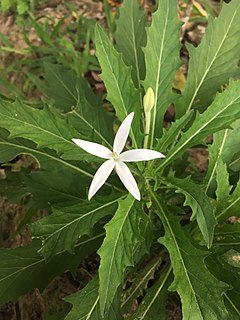
Millets are a group of highly variable small-seeded grasses, widely grown around the world as cereal crops or grains for fodder and human food.

Fonio is the term for two cultivated grasses in the genus Digitaria that are notable crops in parts of West Africa. They are millets with small grains.

Nicotiana longiflora, the longflower tobacco or long-flowered tobacco, is a species of tobacco native to South America that is sometimes cultivated for its tubular flowers that emit a very sweet odour at night.

Cynodon is a genus of plants in the grass family. It is native to warm temperate to tropical regions of the Old World, as well as being cultivated and naturalized in the New World and on many oceanic islands.

Digitaria is a genus of plants in the grass family native to tropical and warm temperate regions but can occur in tropical, subtropical, and cooler temperate regions as well. Common names include crabgrass, finger-grass, and fonio. They are slender monocotyledonous annual and perennial lawn, pasture, and forage plants; some are often considered lawn pests. Digitus is the Latin word for "finger", and they are distinguished by the long, finger-like inflorescences they produce.

Digitaria exilis, referred to as findi or fundi in areas of Africa, such as The Gambia, with English common names white fonio, fonio millet, and hungry rice or acha rice, is a grass species. It is the most important of a diverse group of wild and domesticated Digitaria species known as fonio that are harvested in the savannas of West Africa. The grains are very small. It has potential to improve nutrition, boost food security, foster rural development and support sustainable use of the land. Despite its valuable characteristics and widespread cultivation, fonio has generally received limited attention research and development, which is also why the species is sometimes referred to as an underutilized crop.
The fonio husking machine was invented by Sanoussi Diakité, a Senegalese mechanical engineer. Diakité was awarded the Rolex Award in 1996 for the invention.

Hippobroma longiflora, also called Star of Bethlehem or madamfate, is a flowering plant in the family Campanulaceae. It is the only species in the genus Hippobroma. It is endemic to the West Indies, but has become naturalized across the American tropics and Oceania.

Digitaria sanguinalis is a species of grass known by several common names, including hairy crabgrass, hairy finger-grass, large crabgrass, crab finger grass, purple crabgrass. It is one of the better-known species of the genus Digitaria, and one that is known nearly worldwide as a common weed. It is used as animal fodder, and the seeds are edible and have been used as a grain in Germany and especially Poland, where it is sometimes cultivated. This has earned it the name Polish millet.

Leersia is a genus of plants in the grass family which includes species known generally as cutgrasses.

Billardiera longiflora, the purple apple-berry, is a small Australian vine found in cool, moist forests from southern New South Wales to Tasmania, where it is native. It was described by French botanist Jacques Labillardière in 1805. The slender leafed vine has greenish-yellow flowers and shiny purple fruit. The fruit is edible.

Digitaria ischaemum is a species of crabgrass known by the common names smooth crabgrass and small crabgrass. It is native to Europe and Asia, but it is known throughout much of the warm temperate world as an introduced species and often a common roadside and garden weed. It is an annual grass producing an inflorescence with two or more narrow branches lined with tiny spikelets.
Cuviera is a genus of flowering plants in the family Rubiaceae native to tropical Africa. It was originally described by Augustin Pyramus de Candolle in 1807 and is named after the French naturalist Georges Cuvier.
Digitaria californica is a species of grass known by the common name Arizona cottontop. It is native to the Americas, where it can be found in the southwestern United States, Mexico, Central America, and South America.

Digitaria eriantha, commonly known as digitgrass or Pangola-grass, is a grass grown in tropical and subtropical climates. It grows relatively well in various soils, but grows especially well in moist soils. It is tolerant to droughts, water lodging, suppresses weeds and grows relatively quickly post grazing. This grass demonstrates great potential for farmers in Africa in subtropical and tropical climates, mostly for livestock feed.

Digitaria compacta is a grass species native to India and Indochina. It is cultivated in the Khasi Hills of northeast India, used as a glutinous flour for making bread or porridge, and known as raishan.
Digitaria iburua, commonly known as iburu, is a grass species native to west and west-central tropical Africa, which is cultivated as a grain crop known as black fonio.

Hakea longiflora is a small shrub in the family Proteaceae and is endemic to Western Australia. It has sharp, short, needle-like leaves with white flowers and a prominent red style.

Kalanchoe longiflora, also known as tugela cliff-kalanchoe or long-flower kalanchoe, is a species of the succulent genus Kalanchoe, in the family Crassulaceae. An obscure shrub native to South Africa, it is known for its multi-coloured foliage and yellow flowers, which bloom in autumn to winter.













